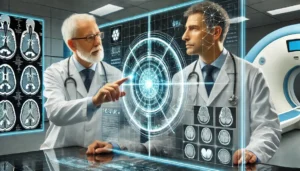Imagine a future where a single injection enables your cells to fight the disease you were born with or where a new organ can be printed with your DNA. This isn’t a distant dream but the vanguard of the biotechnological revolution, fundamentally changing our understanding of health. Rapid advances in genomics, artificial intelligence, and cell technology have transformed biotechnology beyond merely treating symptoms. Biotechnology now provides methods for curing diseases and preventative measures that were previously only a realm of science fiction.
In this new era, we will shift from a universal medical model to highly personalized, proactive, and precise treatments that target the root causes of disease. The fusion of biology and technology heralds a new world of medicine. This ushers in a future where we will significantly extend our healthy lifespans and, more importantly, our lifespans. In the future, medicine will treat diseases and alter our biological destinies.
The Era of Gene Editing and Curative Medicine:
Genetic editing tools like CRISPR-Cas9 and their more precise follow-up technologies, such as base editing and lead editing, are at the forefront of this revolution. Scientists can now directly correct errors in DNA, as these molecular cutting tools have evolved into sophisticated DNA editing software. We are now witnessing the development of unique therapies that could cure previously incurable genetic diseases like sickle cell anemia and certain forms of blindness. By directly repairing the abnormal genes that cause these diseases, the goal expands to more complex diseases, like Huntington’s disease and cystic fibrosis. This technology marks a quantum leap from simply managing chronic diseases to completely curing them. It offers a treatment option and promises lifelong hope for generations of people suffering from genetic diseases.
AI-Driven Drug Discovery and Development:
Artificial intelligence is accelerating the development of new drugs, a process that often took decades and cost billions of dollars. AI programs can now quickly and accurately analyze vast quantities of molecular structures and predict how they interact with human biological targets. This makes it possible to find effective drug candidates in months instead of years, significantly reducing development costs and failure rates. AI also plays a crucial role in the development of new molecules and enhances the efficiency of clinical trials by identifying patient groups that are likely to respond positively. The convergence of biotechnology and artificial intelligence is making new drugs for diseases like cancer and Alzheimer’s better, safer, and more effective.
Personalized Medicine and the Power of Biomarkers:
Biomarkers and multi-omics data (genomics, proteomics, and metabolomics) are being applied in increasingly sophisticated ways to realize personalized treatments. Biotechnology makes it possible to create a unique genetic fingerprint for each individual. This fingerprint reveals the disease risk and potential response to treatment. In oncology, for example, liquid biopsies can detect traces of tumor DNA with just a simple blood draw.
This aids in early cancer detection and allows doctors to understand the effects of treatment in real time. This data-driven approach can tailor treatment plans based on each person’s unique biological makeup. This eliminates trial and error and replaces it with more effective, precise interventions with fewer side effects.
Regenerative Medicine and 3D Bioprinting of the Human Body:
The goal of regenerative medicine is to repair, replace, or regenerate damaged organs and tissues. Stem cell therapy and 3D bioprinting are two emerging technologies that are driving this field. Scientists are investigating how stem cells can be stimulated to differentiate into different cell types. This investigation offers prospects for new treatments for diseases such as heart failure, Parkinson’s disease, and spinal cord injury.
Meanwhile, 3D bioprinting technology is also developing, using bioinks made from the patient’s own cells to create functional living tissue through layer-by-layer stacking. Printing complex, solid organs for transplantation remains a long-term goal, but the technology has already been used to create tissue models for drug testing and skin grafts in burn patients. Ultimately, this technique will make organ donation obsolete.
The Challenges of Access and Ethics:
While biotechnology offers enormous potential, it also presents many pressing challenges. The high cost of these advanced therapies raises important questions about equal access and affordability. This means that some people may benefit more from these medical wonders than others. Ethical issues are also crucial, particularly regarding germline gene editing, as this technology alters the human genome, and these changes can be inherited by future generations. We need strict regulations, open communication, and a strong global commitment to fairness to ensure that the development and application of these advanced technologies benefit everyone, not just a select group.
Conclusion:
The direction of biotechnology development is clear: from basic treatments to highly personalized therapies, from passive treatment to proactive health management, we are experiencing a significant transformation. This revolution, based on gene editing, artificial intelligence, and regenerative medicine, promises to offer solutions to some of the most persistent medical problems that have plagued humanity for centuries. Future developments will require careful consideration of ethical and economic factors, but the reward could be fundamental changes in people’s lifestyles. The next health revolution will not only extend our lifespans but also extend our healthy and fulfilling lives, enabling us to live longer, healthier, and more fulfilling lives than anyone ever imagined.
FAQs:
1. What is the difference between biotechnological medicines and traditional scientific medicines?
Biotechnological medicines are typically derived from large, complex molecules of living organisms. Traditional medicines are typically small, chemically synthesized molecules. Biotechnology often focuses on treating the root cause of diseases.
2. Are gene therapies safe enough for most people?
Gene therapies require extensive testing to ensure their safety. Despite the promising prospects, long-term monitoring is crucial, as the field is still in its early stages and scientists are working to improve the precision of the technology to reduce side effects.
3. How will the application of artificial intelligence in biotechnology affect drug prices?
Initially, these new therapies will be expensive. However, advances in AI-driven detection and manufacturing technologies, along with the possibility of a one-time cure, are aimed at reducing long-term healthcare costs, thus obviating the need for lifelong treatment of chronic diseases.
4. Can biotechnology help in the fight against aging?
Yes, biotechnology research is exploring ways to slow or halt the biological signs of aging. The goal is to extend “healthy lifespan”—the time spent maintaining optimal health, not just biological age.
5. What are the key ethical issues in biotechnology?
One concern is germline gene editing, which irreversibly alters human DNA. Currently, scientists worldwide agree that we must proceed with caution and emphasize the importance of public discussion and strict regulations before any clinical application.




